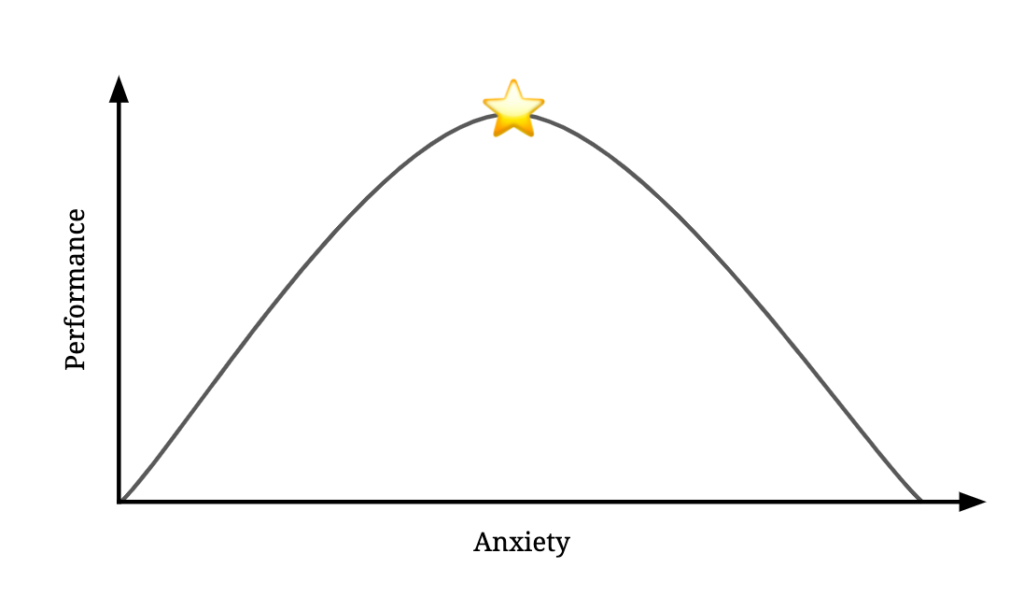As I was chatting with a friend, we noticed that we both felt incredibly excited and anxious about the work we were currently doing. We could not come up with the right word to describe that exact feeling: we were stressed, yes, but not in a negative way. We did worry about the outcome of some of our projects, but we also felt driven and energised.
Worry, stress, and anxiety are very common in demanding jobs, whether people love their job or not. I recently discussed the concept of worrying well. What about stress and anxiety—is there a sweet spot, something that’s strong enough to motivate us to give our best shot to reach our goals, but not strong enough to paralyse us?
It turns out this is the case. In the children’s story The Three Bears, Goldilocks tastes three different bowls of porridge, and finds that she likes the porridge that is neither too hot nor too cold—but just at the right temperature. This concept is known as the Goldilocks Principle and has been used across disciplines to describe something that is not too high, not too low—but just right.
A recent research study from the British Journal of Psychiatry found that school children with high levels of anxiety did badly performance-wise, but that kids with very low levels of anxiety also did not perform well. This is the Goldilocks effect at play: we need an optimal level of anxiety to be able to perform at our best, a level of anxiety that is just right.

How does that work? A theory is that the levels of anxiety are somehow correlated to how much you care about a specific task or a specific outcome. No anxiety at all means a total lack of interest, and thus poor performance results. Too much anxiety, on the other hand, has negative effects on performance by affecting your self-esteem and self-confidence. Some reasonable level of anxiety shows that an individual cares enough about the task at hand, but is still able to keep a clear mind.
This is also why lots of people report performing better under pressure. You procrastinate for two weeks, and then, when the deadline is close, you work your ass off to get the job done—more often than not producing good enough work.
What about stress? As often with mental health, it’s also matter of balance. While anxiety origins from internal thought mechanisms, stress is a response to external factors. Thousands of years ago, such external factors included needing to flee from a predator or other situations where we needed to think and act as fast as possible to ensure our survival.
That’s why stress is not inherently bad: when you’re under stress and need to react quickly and be sharp, your brain releases a hormone called cortisol. This will increase your heart rate and blood pressure, and divert resources away from other tasks—such as inflammatory responses—to help your body focus on more immediate needs.
Cortisol also increases the plasticity of your brain: it means you are able to better think and remember. Short-term stress is not bad for us, and our brain is actually designed to optimise our responses under stress: only about 10% of our cortisol receptors are normally occupied, while the other 90% are just a reserve waiting for a stress response.
Stress becomes dangerous when it goes beyond those short bursts that are quickly dealt with. Cortisol is neurotoxic in large quantities and chronic stress is damaging. Parts of your neurons will shrink, some neurotransmitters that are good in small quantities but bad in large ones will be overproduced, and there will be lots of other bad things happening in your brain, often leading to mental illness. A little bit of cortisol is good, too much is bad. This is why cortisol is often called the “currency of stress”, and there is lots of research going on at the moment targeting cortisol specifically to try and prevent or treat mental health issues.
So how do you find your Goldilocks spot, your perfect levels of stress and anxiety? The answer is that you probably already can tell the difference.
Are you feeling excited in the morning, a bit giddy even, and can’t stop thinking about the projects you are working on? Do you worry sometimes about the next steps or the outcomes, but manage to calm yourself down by writing down a plan to address potential obstacles? Do you have sweaty palms before a big presentation, but feel better once it’s over?
These are all signs you are currently working on interesting stuff and are feeling healthy levels of anxiety. If you stopped feeling any of these emotions, it could be a sign that you are losing interest in your day job or side projects.
Now, are you struggling to fall asleep at night, having trouble to eat, maybe some headaches and an upset stomach? Do you have frequent colds and infections? As we explained, when you’re stressed, cortisol diverts resources away from inflammatory responses to focus on more immediate needs. That’s fine if it’s for a short-term response, but long-term, this may explain why you’ve been having a cold for two months that won’t go away.
Again, not all stress is bad and some level of anxiety can act as a motivation driver. As a knowledge worker, creative, or entrepreneur that usually juggles multiple projects, sometime a day job and a side business at the same time, as well as a family and other obligations, it’s very important to be able to recognise the different types of stress responses we have, and to differentiate between short-term, performance-enhancing stress, and long-term, damaging chronic stress. It’s also important to embrace reasonable levels of anxiety, which you can consider a secondary effect of your excitement.
